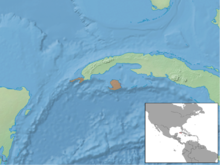Cuban greater funnel-eared bat
| Cuban greater funnel-eared bat | |
|---|---|
| Scientific classification | |
| Kingdom: | Animalia |
| Phylum: | Chordata |
| Class: | Mammalia |
| Order: | Chiroptera |
| Family: | Natalidae |
| Genus: | Natalus |
| Species: | N. primus
|
| Binomial name | |
| Natalus primus (Anthony, 1919)
| |

| |
The Cuban greater funnel-eared bat (Natalus primus) is a species of funnel-eared bat. It is endemic to a cave in westernmost Cuba.[1] it is a member of the family Natalidae.[2]
Taxonomy[]
The bats within the genus Natalus have had a complex taxonomic history due to its morphological conservatism.[3] The taxonomy of Natalidae has been recently updated by the discovery and rediscovery of live species and fossils, and on the basis of new morphological and molecular evidence.[4]
Description[]
The Cuban greater funnel-eared bat has funnel-like ears and a tail as long as the head and body combined.[5] The dimensions/measurements collected on the Cuban greater funnel-eared bat (Natalus primus) were recorded as given. Legs were shorter than the forearm, dorsal hair length was 8–9 mm long, ventral hair length was 7–8 mm long, a single hair was divided into three different colors going from dark on the base, light in the middle, and the tip a little darker than the middle.[6] They have black, stiff hairs above the upper lip, much like a moustache, and white hairs below the lower lip. They have tan and reddish-brown fur with a paler belly.[7]
These bats have a diet consisting largely of moths, crickets, and beetles.[1] In 1992, the first living population was discovered in a cave in Cueva La Barca.[5] Caribbean hurricanes early in the evolutionary history of Natalids may account for specialized cave roosting.[8]
Conservation[]
When Harold E. Anthony described this species in 1919, he thought it was an extinct form[9][10] because it was only known from fossil localities on Cuba, on Isla de la Juventud, Grand Cayman and various islands in the Bahamas. In 1992, a living population has been rediscovered.[5] Natalus primus is considered vulnerable and only inhabits one cave in Cueva La Barca on Isla de la Juventud island and province.[11] The population is abundant in that single cave, but this species is likely to go extinct due to its limited dispersal range,[5] human disturbance and loss of habitat.[12] It is estimated that there are only a few thousand individuals.[1]
This species is known to have become extirpated throughout most of Cuba suggesting a population decline that may have continued until the present.[13] The survival of Cuban bats is threatened by forest destruction and cave modification.[14]
Habitat loss through erosion is a major concern. The ongoing collapse of the cave roof is likely to upset the thermal balance in this hot cave and result in Natalus primus extinction.[5] Cave-dwelling Cuban bat species conservation should be a cooperative effort promoting research and habitat management.[14]
References[]
- ^ a b c d Mancina, C. (2016). "Natalus primus". IUCN Red List of Threatened Species. 2016: e.T136777A22032828. doi:10.2305/IUCN.UK.2016-1.RLTS.T136777A22032828.en. Retrieved 20 November 2021.
- ^ "Mammal's Planet - Species Sheet - Cuban Greater Funnel-eared Bat, Cuban Yellow Bat". Ch Boudet. Archived from the original on 2014-03-01. Retrieved 2014-02-23.
- ^ López-Wilchis, Ricardo; Luis M. Guevara-Chumacero; Neófito ángeles Pérez; Javier Juste; Carlos Ibáñez; Irene D. L. A. Barriga-Sosa (December 2012). "Taxonomic status assessment of the Mexican populations of funnel-eared bats, genus Natalus (Chiroptera: Natalidae)". Acta Chiropterologica. 2. 14 (2): 305–316. doi:10.3161/150811012x661639. hdl:10261/72462. S2CID 85765304.
- ^ Tejedor, Adrian (2011). "Systematics of Funnel-Eared Bats (Chiroptera: Natalidae)" (PDF). Bulletin of the American Museum of Natural History. 353: 1–140. doi:10.1206/636.1. hdl:2246/6120. S2CID 84311591.
- ^ a b c d e "Cuban Greater Funnel-Eared Bat (Natalus primus)". EDGE. The Zoological Society of London. Retrieved 2014-02-23.
- ^ Tejedor, Adrian (2005). "A new species of funnel-eared bat (Natalidae: Natalus) from Mexico". Journal of Mammalogy. 86 (6): 1109–1120. doi:10.1644/1545-1542(2005)86[1109:ANSOFB]2.0.CO;2.
- ^ "Funnel-Eared Bats: Natalidae - Funnel-eared Bat (natalus Stramineus): Species Account". Net Industries. Retrieved 2014-02-24.
- ^ Dávalos, LM (October 2005). "Molecular phylogeny of funnel-eared bats (Chiroptera: Natalidae), with notes on biogeography and conservation". Molecular Phylogenetics and Evolution. 37 (1): 91–103. doi:10.1016/j.ympev.2005.04.024. PMID 15967682.
- ^ Anthony, Harold Elmer (1919). "Mammals collected in eastern Cuba in 1917: with descriptions of two new species". Bulletin of the American Museum of Natural History. 41: 625–643, 3 plates.
- ^ Allen, Glover M. (1942), Extinct and vanishing mammals of the western hemisphere, with the marine species of all the oceans, American Committee for International Wild Life Protection, pp. 29–30.
- ^ "Critical Ecosystem Partnership Fund - Conservation Outcomes - Caribbean Islands". Conservation International. Archived from the original on 2014-02-16. Retrieved 2014-02-23.
- ^ "The world's 100 most threatened species - Are they priceless or worthless?". Wildlife Extra. Retrieved 2014-02-23.
- ^ Tejedor, Ardian; Valeria DA C. Tavares; Gilberto Silva-Taboada (2005-10-27). "A revision of extant Greater Antillean bats of the genus Natalus". American Museum Novitates. 3493: 1–22. doi:10.1206/0003-0082(2005)493[0001:AROEGA]2.0.CO;2. Retrieved 2014-02-23.
- ^ a b Mancina, Carlos; Làzrao Echenique-Diaz; Adrian Tejedor; Lainet Garcìa; Angel Daniel-Alvarez; Miguel Ortega-Huerta (2007). "Endemics under threat: an assessment of the conservation status of Cuban bats". Hystrix: The Italian Journal of Mammalogy. 18 (1). Retrieved 2014-02-23.
- IUCN Red List vulnerable species
- Natalus
- Bats of the Caribbean
- Endemic fauna of Cuba
- Isla de la Juventud
- Mammals of Cuba
- Cave mammals
- Mammals described in 1919
